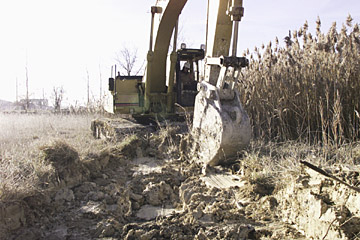
Choosing the location for an earth pond
 The most important
factors to consider when building a pond without a liner are
location and soil quality. You can get an idea for both by
digging test pits in an area where you want a large pond to
go. Each pit should be about eight to ten feet deep and
should be excavated during your driest season. You're
looking for rock ledges (bad), clay (good), and high groundwater
(good).
The most important
factors to consider when building a pond without a liner are
location and soil quality. You can get an idea for both by
digging test pits in an area where you want a large pond to
go. Each pit should be about eight to ten feet deep and
should be excavated during your driest season. You're
looking for rock ledges (bad), clay (good), and high groundwater
(good).
In different parts of
his book, Matson writes that pond
soil should be either 10% to 20% clay,
or at least 20% clay. As far as I can tell, more clay is
almost always better, unless you're building a dam (more on that
in a later post), in which case pure clay won't be as
stable. And, while we're talking about the earth, hitting
rock bottom in your test pit is a sign that you should put your
pond someplace else --- ledges, especially, allow water to flow
right out the bottom of your pond and disappear.
Equally as important
as the soil, you're looking for high groundwater in your test
pits. In a pond without a dam, the level of the groundwater
will tell you the eventual low-water level of your pond, so not
hitting water in your test pits is another sign you should look
for a different pond location. Of course, groundwater moves
slowly, and in
my experiment I
found that it took several hours for my excavation to fill up with
water, so give your test pits a day or two to fill before calling
them failures.
| This
post is part of our Earth
Ponds lunchtime series.
Read all of the entries: |
Want more in-depth information? Browse through our books.
Or explore more posts by date or by subject.
About us: Anna Hess and Mark Hamilton spent over a decade living self-sufficiently in the mountains of Virginia before moving north to start over from scratch in the foothills of Ohio. They've experimented with permaculture, no-till gardening, trailersteading, home-based microbusinesses and much more, writing about their adventures in both blogs and books.
Want to be notified when new comments are posted on this page? Click on the RSS button after you add a comment to subscribe to the comment feed, or simply check the box beside "email replies to me" while writing your comment.
